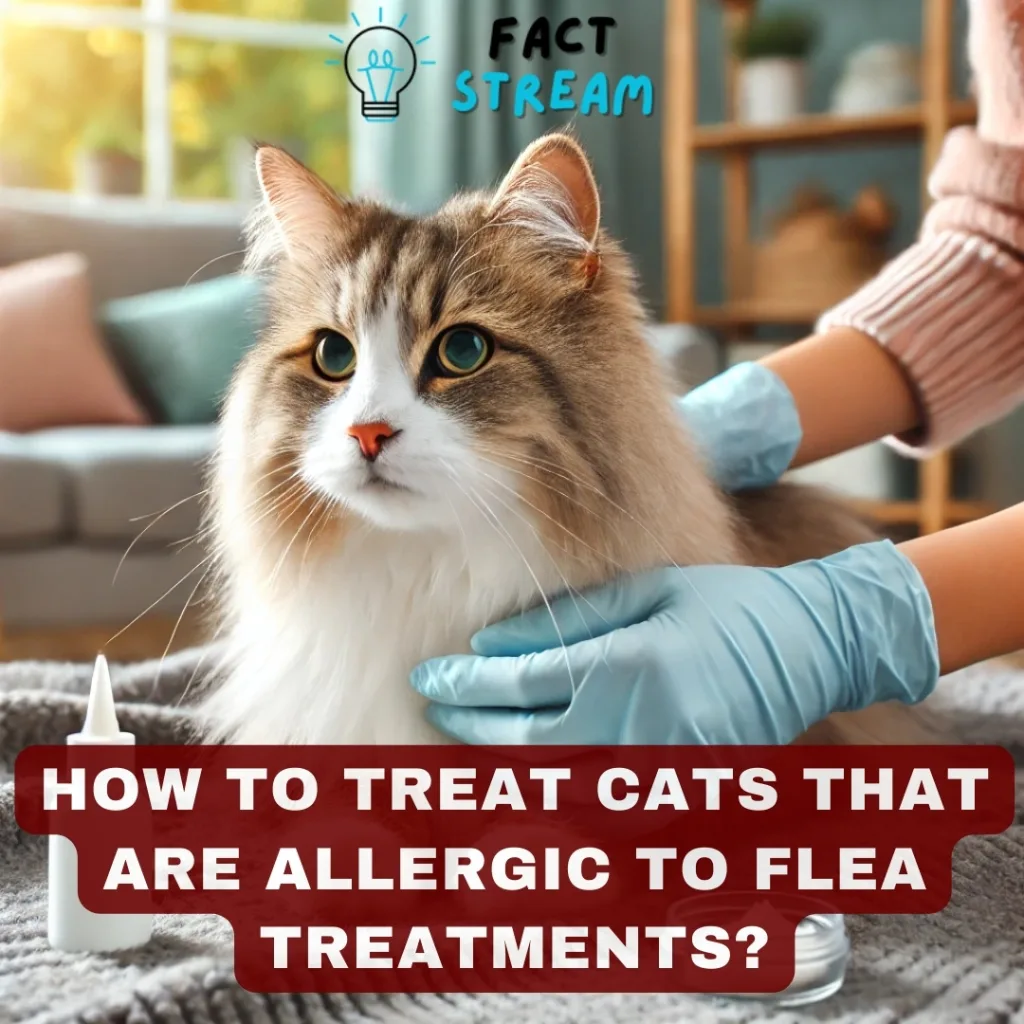How to Treat Cats That Are Allergic to Flea Treatments?
Fleas are a common nuisance for cats, leading to itching and discomfort. But imagine your cat being allergic to the very treatment meant to relieve them! Flea treatment allergies in cats are more common than you might think. If your feline friend seems to be getting worse after flea treatment, you’re not alone. This guide will explain how to spot the signs of flea treatment allergies, what to do about them, and how to keep those pesky fleas away without making your cat miserable.
Is It a Flea Allergy or a Flea Treatment Allergy?
It’s important to understand the difference between a flea allergy, also known as flea allergy dermatitis (FAD), and a flea treatment allergy. Both can cause similar symptoms, like itching and scratching, so it’s easy to get them confused.
Flea allergy dermatitis happens when your cat’s immune system overreacts to proteins found in flea saliva. This reaction causes intense itching and skin irritation, even if there’s just one flea bite.
Flea treatment allergy, on the other hand, is a reaction to something in the flea medication itself. It could be the active ingredient or an inactive ingredient, like a dye or fragrance.
Here are a few clues to help you tell the difference:
- Timing: A flea treatment allergy will typically cause symptoms immediately or shortly after application. Flea allergy dermatitis, however, can take a while to develop as the cat needs to be bitten by a flea first.
- Location: Flea treatment allergies often cause a reaction at the site of application, like between the shoulder blades. Flea allergies can cause itching anywhere on the body, but are often concentrated on the back, hind legs, and base of the tail.
- Severity: Flea treatment allergies can trigger severe reactions, even with just a small amount of exposure.
If you suspect your cat is having a reaction to their flea treatment, stop using it immediately and contact your veterinarian.
Recognizing the Symptoms of a Flea Treatment Allergy
Flea treatment allergies can manifest in a variety of ways, making it crucial to be vigilant and recognize the signs early on. Here are the most common symptoms to look out for:
- Excessive scratching, licking, and biting: This is the most obvious sign. Your cat might be relentlessly targeting a specific area or going after their entire body.
- Hair loss: All that scratching and licking can lead to patches of hair loss (alopecia). You might notice bald spots or areas where the fur is thinned out.
- Skin changes: Look for redness, inflammation, scabs, crusts, or even small, raised bumps. These are all signs that your cat’s skin is irritated and inflamed.
- Drooling, vomiting, or diarrhea: While these are less common, they can occur if your cat ingests a significant amount of the flea treatment. This is more likely to happen with topical treatments that the cat can lick off their fur.
- Lethargy or loss of appetite: Your cat might seem more tired than usual and less interested in their food if they’re feeling unwell due to the allergic reaction.
- Difficulty breathing: This is a serious symptom that requires immediate veterinary attention. It could indicate that your cat is having a severe, potentially life-threatening allergic reaction (anaphylaxis).
What to Do if You Suspect a Flea Treatment Allergy
If you notice any of these symptoms after applying a flea treatment, it’s important to act quickly. Here’s what to do:
- Stop using the flea treatment immediately. This will prevent further exposure and give your cat’s body a chance to recover.
- Contact your veterinarian. They can assess the situation, determine the severity of the reaction, and recommend the best course of action.
- Be prepared to provide information. Your vet will want to know the name of the flea treatment you used, when you applied it, and what symptoms your cat is experiencing.
- Follow your vet’s instructions carefully. They may recommend bathing your cat with a mild shampoo to remove any remaining medication, or they may prescribe medications to alleviate the symptoms and prevent complications.
Treatment Options for Flea Treatment Allergies
Treating a flea treatment allergy involves a two-pronged approach: addressing the allergic reaction itself and providing effective flea control without triggering further allergic reactions.
Addressing the Allergic Reaction:
- Antihistamines: These medications help block the release of histamine, a chemical involved in allergic reactions.
- Corticosteroids: These are powerful anti-inflammatory drugs that can quickly reduce itching, swelling, and redness.
- Supportive care: Depending on the severity of the reaction, your cat might need IV fluids, oxygen therapy, or other supportive measures.
Flea Control for Allergic Cats:
- Switching to a different active ingredient: Many different flea medications are available, so your vet can help you find one that’s less likely to cause an allergic reaction in your cat.
- Changing the application method: Instead of a topical treatment, your vet might recommend an oral medication or an injectable flea preventative.
- Environmental control: This is crucial for preventing flea infestations and minimizing your cat’s exposure to fleas. This might involve:
- Treating all pets in your household with a vet-approved flea preventative
- Washing your cat’s bedding regularly in hot water
- Vacuuming your home frequently
- Using a pet-safe flea spray for your home and yard
- Keeping your cat indoors
How to Soothe Flea Allergy Dermatitis in Cats
When your cat is suffering from flea allergy dermatitis, it’s heartbreaking to see them so itchy and uncomfortable. Here are a few things you can do to help soothe their irritated skin:
- Cool compresses: Applying a cool compress to the affected areas can help reduce inflammation and provide some relief from the itching. Simply soak a washcloth in cool water, wring it out, and gently hold it against your cat’s skin for a few minutes.
- Medicated shampoos: Your vet might recommend a medicated shampoo containing ingredients like oatmeal, aloe vera, or chlorhexidine to help soothe and cleanse your cat’s skin.
- Omega-3 fatty acids: These essential fatty acids have anti-inflammatory properties and can help improve skin health. You can add omega-3 supplements to your cat’s food or give them fish oil capsules.
- Preventing scratching: Excessive scratching can worsen skin irritation and lead to infections. Your vet might recommend a cone collar (also known as an Elizabethan collar) or a soft, protective bodysuit to prevent your cat from scratching.
Flea Allergy Dermatitis Cats
Flea allergy dermatitis (FAD) is one of the most common skin allergies in cats. It’s triggered by an allergic reaction to flea saliva. Even a single bite can cause intense itching, hair loss, and skin lesions.
Flea Allergy Dermatitis Home Remedy
While home remedies can provide some relief from flea allergy dermatitis symptoms, it’s crucial to consult with your veterinarian for proper diagnosis and treatment. They can guide you on the safest and most effective options for your cat. Here’s one home remedy discussed in the sources:
- Soothing baths: Giving your cat a lukewarm bath with a gentle, hypoallergenic shampoo can help remove fleas and soothe irritated skin. Some cat owners use Dawn dish soap for flea removal, but it’s important to note that this is not specifically formulated for cats and may dry out their skin. Always rinse your cat thoroughly after any bath to remove all traces of soap residue.
Can Cats Die from Flea Allergy?
While a flea allergy itself is not typically fatal, the sources note that severe, untreated flea infestations can lead to complications that could be life-threatening. For example:
- Anemia: Massive flea infestations can cause significant blood loss, particularly in kittens or cats with compromised immune systems.
- Secondary infections: Constant scratching and licking can break the skin, creating entry points for bacteria and other pathogens. These infections can become serious if left untreated.
- Underlying health conditions: Fleas can transmit diseases and parasites that can exacerbate existing health problems.
Holistic Approaches to Flea Control
While conventional flea treatments are usually the most effective, some cat owners prefer to explore more natural options, especially if their cat has sensitive skin. Always consult with your veterinarian before using any home remedies to ensure their safety and effectiveness. Here are a few holistic approaches you might discuss with your vet:
- Diatomaceous earth: This natural powder consists of fossilized diatoms, tiny aquatic organisms. It works by dehydrating and killing fleas. When using diatomaceous earth, it’s important to choose food-grade diatomaceous earth and avoid inhaling the powder, as it can irritate the lungs.
- Essential oils: Certain essential oils, like lavender, cedarwood, and lemongrass, are believed to have flea-repelling properties. However, it’s important to use essential oils with caution around cats, as some oils can be toxic to them. Always dilute essential oils properly and consult with your vet before applying them to your cat or their environment.
- Herbal remedies: Some herbs, like rosemary, peppermint, and eucalyptus, are thought to have flea-repelling properties. You can find herbal flea sprays and shampoos at pet stores or online. As with essential oils, it’s essential to use herbal remedies cautiously and consult with your vet before use.
Your Vet is Your Partner in Flea Allergy Management
Dealing with a cat who’s allergic to flea treatments can be challenging, but with the right approach, you can help your furry friend live a comfortable and flea-free life. By working closely with your veterinarian, you can develop a personalized plan that addresses your cat’s individual needs and helps them stay happy, healthy, and itch-free. Remember, communication is key! Don’t hesitate to ask your vet any questions you have and keep them updated on your cat’s progress.


